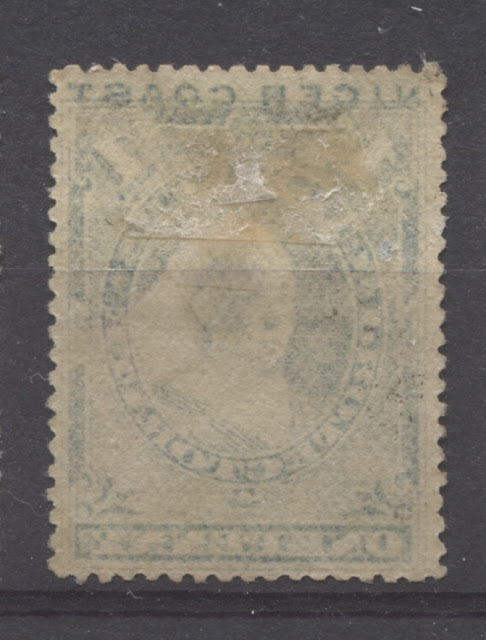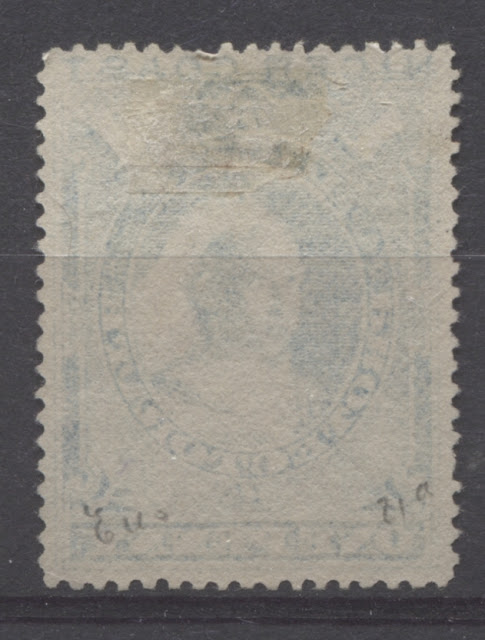Last week I covered most of the aspects of the 1d blue stamp from this first Waterlow printed series. However, the two aspects that I did not cover were the paper, gum and perforations. Those aspects of this stamp will be the subject of this week's post.
Perforations
According to Gibbons, there are 4 basic perforations:
- 14.5 to 15.
- 13.5 to 14.
- 13.5 to 14 compound with 12-13 and
- 12-13.
However, in reality the measurements are quite a bit more complicated than that. So far, I have found the following perforation measurements:
- 14.9 x 15 x 15 x 15
- 14.6 x 14.75 x 14.6 x 14.75
- 15
- 15 x 14.6 x 14.8 x 14.6
- 14.6 x 14.5 x 14.7 x 14.5
- 14.5
- 14 x 12;12.6
- 14.2 x 14
- 14.5 x 14.5 x 14.8 x 14.5
- 14;12.3 x 14
- 14.4 x 14.6
- 14.6 x 14.5 x 14.5 x 14.6
- 15 x 14.8
- 15 x 14.6 x 14.5 x 14.6
- 13.9 x 12.4;14 x 14 x 14
- 14.8 x 14.9
- 14.8 x 14.5
- 14
- 14 x 13.9
- 14.7 x 14.7 x 14.7 x 14.6
- 14.5 x 14.5 x 14.5 x 14.75
- 14.5 x 14.7
- 14.9
- 14.6 x 15 x 14.8 x 15.1
- 15 x 14.9
- 14.9 x 14.6
- 14.6 x 14.5
- 14.6 x 14.8
- 14.75 x 14.5
- 14;12.3
- 15 x 15 x 14.7 x 15
- 14.6 x 15
- 15.1
- 15 x 15.1 x 15.1 x 15
- 14.6 x 14.7 x 14.7 x 14.7
- 14 x 13.7;12.4
- 12.1;12.7 x 13.2;12.8;13 x 14 x 13.9;13
- 15 x 13.65 x 15 x 15
- 15 x 14.6 x 14.8 x 14.5
- 14.3 x 14.5 x 14.5 x 14.5
- 15 x 15 x 15 x 15.1
- 14.4 x 14.1;12.1 x 14 x 12.1;14.1
- 14 x 14.1;12.2 x 14;12.2 x 12.2;14
- 12.5 x 14;
- 14 x 14;12.2
- 13.5 x 14;12.8
- 14.9 x 14.9;14.4 x 14.9 x 14.7
Where I have a measurement denoted as say 14.9;14.4 this means that for a portion of the side the gauge is 14.9, and then it switches to 14.4 for the remaining length of that side. If you try to obtain a single measurement for the entire side, you will not be able, try as you might to match all of the lines on the instanta gauge with all the teeth.
What is very interesting is that by far, the most common perforations are 15 and 14 exactly on all 4 sides. I have 23 examples of the perf. 15 and 5 of perf. 14, compared with just 1-3 examples of all the other measurements. In most cases I have only one example of a measurement.
In terms of the Gibbons listings:
- 14.5 to 15 would include 1-6, 9, 11-14, 16-17, 20-29, 31-35, 39-41, 47 above.
- 13.5 to 14 would include 8, 18-19 above.
- 13.5 to 14 compound 12-13 would include 7, 10, 15, 30, 36, 37, 42-46
I have never seen an example of a perf. 12-13, and 38 is an unlisted compound which would be closest to 15 compound with 13.5. What is curious about this is that it shows how catalogue values are often not tied to scarcity in the strictest sense. Clearly the perfs between 14.5 and 15 are the most common, and represent the majority of examples. Yet, the 13.5 to 14 measurements are scarcer than the 13.4 to 14 compound with 12-13 perfs. But the perf. 14.5-15 list in Gibbons for 5-6 pounds, whereas the 13.5 to 14 measurements list for only 4-4.75 pounds, even though they are demonstrably scarcer. The 13.5 to 14 compound with 12-13 measurements list for 25-30 pounds. That is probably on the mark, given that I only have 1 example of each measurement - 11 stamps. But the perf. 13.5 to 14 measurements are clearly undervalued, given that I have just 3 examples out of 85 stamps.
Paper
In examining these stamps, I have found four different paper types. All four are vertical wove papers. I have yet to find an example of the 1d stamp on horizontal wove paper. The four paper types are shown all together below:
The main difference between these paper types is the opacity, and the fineness of the mesh. The two stamps on the left are relatively translucent, while the paper of the two stamps on the right is opaque.
To appreciate the differences in weave, it is necessary to look at each paper individually, close up. So, to that end, I show each of the above stamps below:
Here, you can see that the paper is highly translucent, and you can just make out the coarse vertical mesh in the paper, though it is not particularly strong.
This paper is also translucent, but this time the coarse mesh is much more visible and prominent.
This paper shows a slight translucency, but the mesh is so fine as to be almost invisible.
This paper is largely opaque, with coarse mesh that you can clearly see if you concentrate your gaze toward the middle of the stamp.
Gum
The gum on this issue shows only slight variation it is generally thin and colourless. However, there is a fair amount of variation in the sheen, with some stamps showing a satin sheen, and others having gum that shows a definite semi-gloss sheen.
This concludes my examination of the 1d blue from this series. Next week I will look at the 2d green.







